Could We Create Dark Matter?
Could we create dark matter?
85% of the matter in our universe is a mystery. We don’t know what it’s made of, which is why we call it dark matter. But we know it’s out there because we can observe its gravitational attraction on galaxies and other celestial objects.

We’ve yet to directly observe dark matter, but scientists theorize that we may actually be able to create it in the most powerful particle collider in the world. That’s the 27 kilometer-long Large Hadron Collider, or LHC, in Geneva, Switzerland.

So how would that work? In the LHC, two proton beams move in opposite directions and are accelerated to near the speed of light. At four collision points, the beams cross and protons smash into each other.

Protons are made of much smaller components called quarks and gluons.

In most ordinary collisions, the two protons pass through each other without any significant outcome.

However, in about one in a million collisions, two components hit each other so violently, that most of the collision energy is set free producing thousands of new particles.

It’s only in these collisions that very massive particles, like the theorized dark matter, can be produced.

So it takes quadrillions of collisions combined with theoretical models to even start to look for dark matter. That’s what the LHC is currently doing. By generating a mountain of data, scientists at CERN are hoping to find more tiny bumps in graphs that will provide evidence for yet unknown particles, like dark matter. Or maybe what they’ll find won’t be dark matter, but something else that would reshape our understanding of how the universe works entirely.
And that’s part of the fun at this point. We have no idea what they’re going to find.
From the TED-Ed Lesson Could we create dark matter? - Rolf Landua
Animation by Lazy Chief
More Posts from Venusearthpassage and Others

So NASA won the internet today…









Comparison of the planets of the solar system, Pluto and Sun in relation to the earth.
Images: commons.wikimedia (Sun: Alan Friedman)
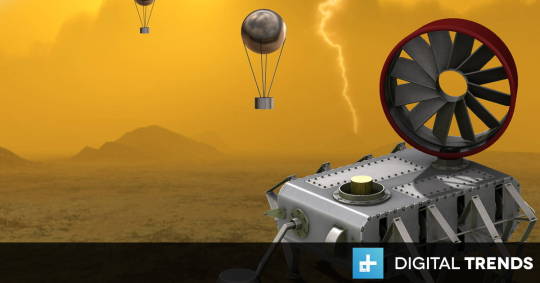
NASA is developing a rover for Venus that could survive the planet’s tumultuous atmosphere.

This is an image of Venus taken in 1974 by NASA’s Mariner 10 space probe. The planet is blanketed by a thick veil of clouds high in carbon dioxide.

(NASA) Venus at Night in Infrared from Akatsuki
Image Credit: JAXA, ISAS, DARTS; Processing & Copyright: Damia Bouic
Why is Venus so different from Earth? To help find out, Japan launched the robotic Akatsuki spacecraft which entered orbit around Venus late in 2015 after an unplanned five-year adventure around the inner Solar System. Even though Akatsuki was past its original planned lifetime, the spacecraft and instruments were operating so well that much of its original mission was reinstated. Also known as the Venus Climate Orbiter, Akatsuki’s instruments investigated unknowns about Earth’s sister planet, including whether volcanoes are still active, whether lightning occurs in the dense atmosphere, and why wind speeds greatly exceed the planet’s rotation speed. In the featured image taken by Akatsuki’s IR2 camera, Venus’s night side shows a jagged-edged equatorial band of high dark clouds absorbing infrared light from hotter layers deeper in Venus’ atmosphere. The bright orange and black stripe on the upper right is a false digital artifact that covers part of the much brighter day side of Venus. Analyses of Akatsuki images and data has shown that Venus has equatorial jet similar to Earth’s jet stream.
Source
Ten Interesting facts about Venus
As one of the brightest objects in the sky, Venus has been a major fixture in human culture for as long as records have existed. It has been made sacred to gods of many cultures, and has been a prime inspiration for writers and poets as the “morning star” and “evening star”. Venus was the first planet to have its motions plotted across the sky, as early as the second millennium BC.
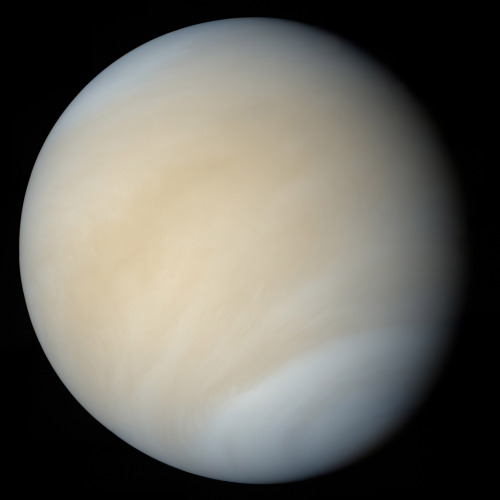
Venus is the second planet from the Sun, orbiting it every 224.7 Earth days. It has the longest rotation period (243 days) of any planet in the Solar System and rotates in the opposite direction to most other planets.

It does not have any natural satellites. It is named after the Roman goddess of love and beauty.
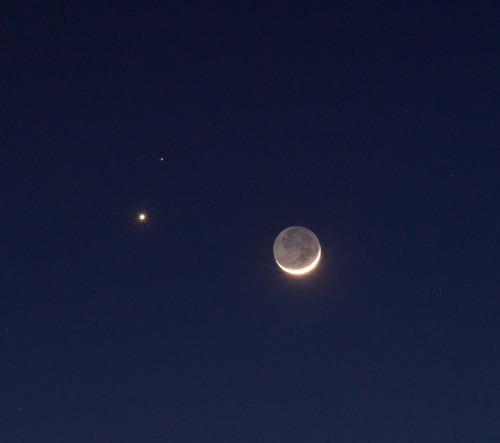
It is the second-brightest natural object in the night sky after the Moon, reaching an apparent magnitude of −4.6 – bright enough to cast shadows at night and, rarely, visible to the naked eye in broad daylight.

Venus is a terrestrial planet and is sometimes called Earth’s “sister planet” because of their similar size, mass, proximity to the Sun, and bulk composition.

It is radically different from Earth in other respects. It has the densest atmosphere of the four terrestrial planets, consisting of more than 96% carbon dioxide. The atmospheric pressure at the planet’s surface is 92 times that of Earth, or roughly the pressure found 900 m (3,000 ft) underwater on Earth. Venus is by far the hottest planet in the Solar System, with a mean surface temperature of 735 K (462 °C; 863 °F), even though Mercury is closer to the Sun.

As the closest planet to Earth, Venus has been a prime target for early interplanetary exploration. It was the first planet beyond Earth visited by a spacecraft (Mariner 2 in 1962), and the first to be successfully landed on (by Venera 7 in 1970). Venus’s thick clouds render observation of its surface impossible in visible light, and the first detailed maps did not emerge until the arrival of the Magellan orbiter in 1991. Plans have been proposed for rovers or more complex missions, but they are hindered by Venus’s hostile surface conditions.

Much of the Venusian surface appears to have been shaped by volcanic activity. Venus has several times as many volcanoes as Earth, and it has 167 large volcanoes that are over 100 km (62 mi) across. The only volcanic complex of this size on Earth is the Big Island of Hawaii. This is not because Venus is more volcanically active than Earth, but because its crust is older. Earth’s oceanic crust is continually recycled by subduction at the boundaries of tectonic plates, and has an average age of about 100 million years, whereas the Venusian surface is estimated to be 300–600 million years old.

As it orbits the Sun, Venus displays phases like those of the Moon in a telescopic view. The planet appears as a small and “full” disc when it is on the opposite side of the Sun (at superior conjunction). Venus shows a larger disc and “quarter phase” at its maximum elongations from the Sun, and appears its brightest in the night sky. The planet presents a much larger thin “crescent” in telescopic views as it passes along the near side between Earth and the Sun. Venus displays its largest size and “new phase” when it is between Earth and the Sun (at inferior conjunction). Its atmosphere is visible through telescopes by the halo of sunlight refracted around it.

The Venusian orbit is slightly inclined relative to Earth’s orbit; thus, when the planet passes between Earth and the Sun, it usually does not cross the face of the Sun. Transits of Venus occur when the planet’s inferior conjunction coincides with its presence in the plane of Earth’s orbit. Transits of Venus occur in cycles of 243 years with the current pattern of transits being pairs of transits separated by eight years, at intervals of about 105.5 years or 121.5 years—a pattern first discovered in 1639 by the English astronomer Jeremiah Horrocks.

In 1967, Venera 4 found Venus’s magnetic field to be much weaker than that of Earth. This magnetic field is induced by an interaction between the ionosphere and the solar wind, rather than by an internal dynamo as in the Earth’s core. Venus’s small induced magnetosphere provides negligible protection to the atmosphere against cosmic radiation.
source
images: Mattias Malmer/NASA/JPL, Peter Barvoets, Soviet Planetary Exploration Program, NSSDC, Marc Lecleire, ESA, C. Carreau,

Thoughts on revisting Venus










Why Isn’t Our Universe Perfectly Smooth?
“This seems, at first glance, to pose a tremendous problem. If inflation stretches space to be flat, uniform, and smooth, indistinguishably so from perfection, then how did we arrive at a clumpy Universe today? Both Newton’s and Einstein’s theories of gravity are unstable against imperfections, meaning that if you start with an almost-but-not-quite perfectly smooth Universe, over time, the imperfections will grow and you’ll wind up with structure. But if you start with perfect smoothness, with literally no imperfections, you’re going to remain smooth forever. Yet this doesn’t jibe with the Universe we observe at all; it had to have been born with imperfections in its matter density.”
One of the great successes of cosmic inflation is to set up the initial conditions for the Big Bang that we knew we needed, including giving us a Universe that had the same temperature and density everywhere. But this couldn’t have been a perfect smoothness, otherwise we’d never have formed stars, galaxies, and the cosmic large-scale structure we observe today in the space we inhabit. So how did we come to be clumpy? The Universe must have been born with initial imperfections in them. If you treat inflation as a classical field, you’ll never get them that way, but if you recognize that it’s a quantum field, with the associated quantum fluctuations that we know must be there, the whole story changes. Not only does inflation give you these cosmic imperfections, but it gives you the full spectrum of them that you can then go check against observations.
These predictions were made in the early 1980s, and were verified decades later by COBE, WMAP, and Planck. It’s a huge victory for a great scientific theory!

TODAY IN HISTORY: Planet Venus, observed by NASA’s Pioneer 12 space probe on February 26, 1979.
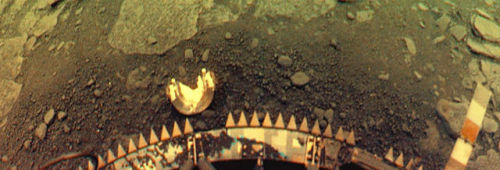
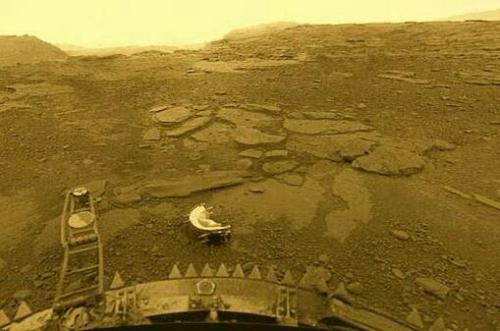
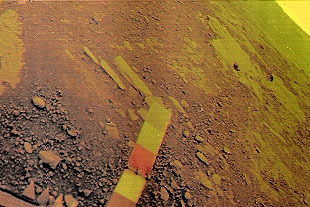
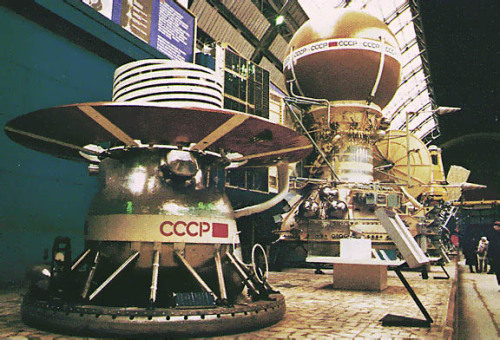
Venera
The Venera series space probes were developed by the Soviet Union between 1961 and 1984 to gather data from Venus, Venera being the Russian name for Venus. As with some of the Soviet Union’s other planetary probes, the later versions were launched in pairs with a second vehicle being launched soon after the first of the pair.
Ten probes from the Venera series successfully landed on Venus and transmitted data from the surface of Venus, including the two Vega program and Venera-Halley probes. In addition, thirteen Venera probes successfully transmitted data from the atmosphere of Venus.
Among the other results, probes of the series became the first human-made devices to enter the atmosphere of another planet (Venera 4 on October 18, 1967), to make a soft landing on another planet (Venera 7 on December 15, 1970), to return images from the planetary surface (Venera 9 on June 8, 1975), and to perform high-resolution radar mapping studies of Venus (Venera 15 on June 2, 1983). The later probes in the Venera series successfully carried out their mission, providing the first direct observations of the surface of Venus. Since the surface conditions on Venus are extreme, the probes only survived on the surface for durations varying between 23 minutes (initial probes) up to.
source
-
 fa1rysk4tes liked this · 4 years ago
fa1rysk4tes liked this · 4 years ago -
 ayumunoya liked this · 4 years ago
ayumunoya liked this · 4 years ago -
 lorenla liked this · 4 years ago
lorenla liked this · 4 years ago -
 spacial-pieceofshit reblogged this · 4 years ago
spacial-pieceofshit reblogged this · 4 years ago -
 spacial-pieceofshit liked this · 4 years ago
spacial-pieceofshit liked this · 4 years ago -
 thedreamchapter11 liked this · 4 years ago
thedreamchapter11 liked this · 4 years ago -
 angrytigercollector liked this · 4 years ago
angrytigercollector liked this · 4 years ago -
 oebelus reblogged this · 4 years ago
oebelus reblogged this · 4 years ago -
 erick133118-blog liked this · 4 years ago
erick133118-blog liked this · 4 years ago -
 shybailifffishlight liked this · 5 years ago
shybailifffishlight liked this · 5 years ago -
 hed-n-the-clouds liked this · 5 years ago
hed-n-the-clouds liked this · 5 years ago -
 electroweak liked this · 5 years ago
electroweak liked this · 5 years ago -
 estellar-crash liked this · 5 years ago
estellar-crash liked this · 5 years ago -
 jossmoon117 liked this · 5 years ago
jossmoon117 liked this · 5 years ago -
 mfyk liked this · 5 years ago
mfyk liked this · 5 years ago -
 lezzveggmair liked this · 5 years ago
lezzveggmair liked this · 5 years ago -
 vickyro98 reblogged this · 5 years ago
vickyro98 reblogged this · 5 years ago -
 vickyro98 liked this · 5 years ago
vickyro98 liked this · 5 years ago -
 drravenclawholmes9 liked this · 5 years ago
drravenclawholmes9 liked this · 5 years ago -
 the-deepboba reblogged this · 5 years ago
the-deepboba reblogged this · 5 years ago -
 unutmakdiye reblogged this · 5 years ago
unutmakdiye reblogged this · 5 years ago -
 greeneyednerd reblogged this · 5 years ago
greeneyednerd reblogged this · 5 years ago -
 greeneyednerd liked this · 5 years ago
greeneyednerd liked this · 5 years ago -
 the-invisible-self reblogged this · 5 years ago
the-invisible-self reblogged this · 5 years ago -
 wicked-books-101 liked this · 5 years ago
wicked-books-101 liked this · 5 years ago -
 urcussovich liked this · 5 years ago
urcussovich liked this · 5 years ago -
 starting-anewww reblogged this · 5 years ago
starting-anewww reblogged this · 5 years ago -
 kingofthespidermen-blog liked this · 5 years ago
kingofthespidermen-blog liked this · 5 years ago -
 annoyingdonkeyfestivalpasta-blog liked this · 5 years ago
annoyingdonkeyfestivalpasta-blog liked this · 5 years ago -
 eros-connection liked this · 5 years ago
eros-connection liked this · 5 years ago -
 ijustlikenaturealot-blog liked this · 5 years ago
ijustlikenaturealot-blog liked this · 5 years ago -
 mmiishel liked this · 5 years ago
mmiishel liked this · 5 years ago -
 sneaking-toss-around reblogged this · 5 years ago
sneaking-toss-around reblogged this · 5 years ago